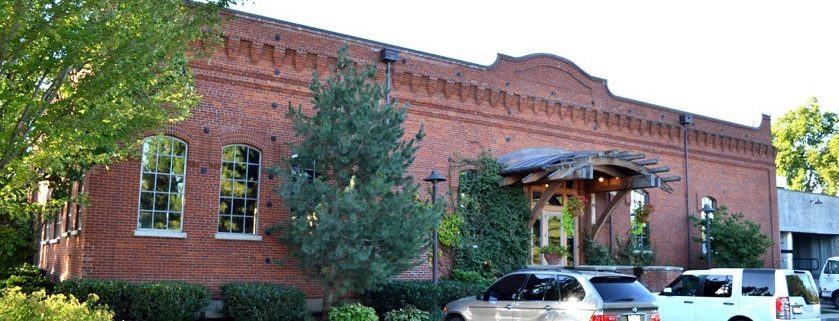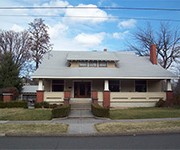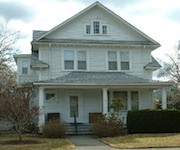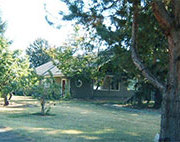History of 511 North Second Avenue, Walla Walla, WA
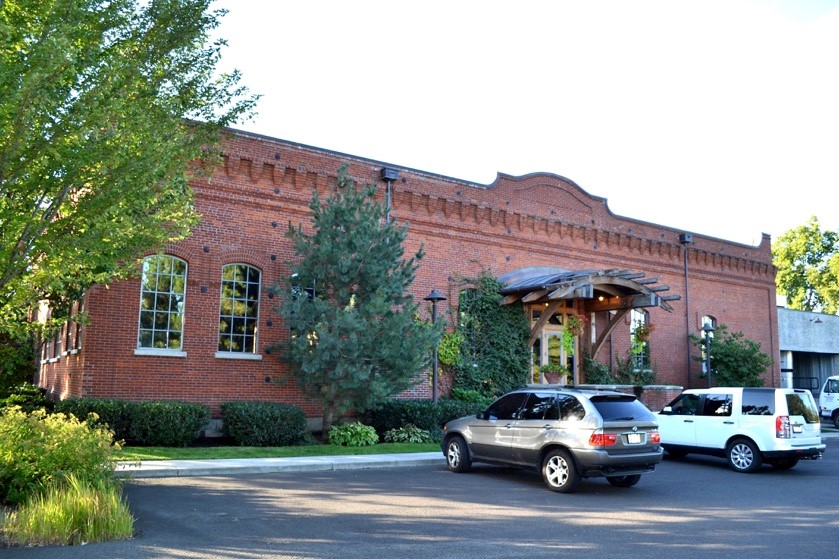
A current photo of the former Interior Grocery building showing the north façade and a hint of the 2nd Avenue façade on the left.
Summary Legal Description
Sheil’s Addition (A/27), Block 2, Lots 1-3 plus strip to East; also Easterly 187.5’ of Vacant Elm Street plus strip to East.
Full Legal Description
Lots 1, 2, and 3 of Block 2 of Sheil’s Addition per the official plat thereof recorded in Plat Book A at Page 27 in the office of the Auditor of Walla Walla County Washington together with a portion of Second Avenue vacated per the City of Walla Walla Ordinance A-234 and the portion of Elm Street vacated per the City of Walla Walla Ordinance A-2767, being a portion of the West half of Section 20, Township 7 North, Range 36 East, Willamette Meridian, described more particularly as follows:
Commencing at the Southwest corner of Lot 5 in said Block 2; Thence North 58°37’34” East for a distance of 119.94 feet along the South line of Lots 5 and 4 in Block 2 to the Southwest corner of Lot 3 and the true point of beginning for this legal description; Thence North 31°20’15” West for a distance of 200.00 feet along the West line of Lot 3 and the Northerly projection thereof to the North line of Elm Street; Thence North 58°37’34” East for a distance of 187.38 feet along the North line of Elm Street to the Northeast corner of said street which was vacated per City of Walla Walla Ordinance A-2767; Thence South 31°20’38” East for a distance of 200.00 feet along the East line of said vacated Elm Street and the East line of that portion of Second Avenue which was vacated by the City of Walla Walla Ordinance A-234 to said East line intersection with the Easterly projection of the South line of Lot 1 in aforesaid Block 2; Thence South 58°37’34” West for a distance of 187.40 feet along said Easterly projection and the South line of Lots 1, 2, and 3 to THE TRUE POINT OF BEGINNING.
Title and Occupant History
Washington Territory was created in 1853. In 1884, the new territorial legislature created Walla Walla County, which stretched from the crest of the Cascade Mountains to the crest of the Rocky Mountains in the present states of Washington, Idaho and Montana. In 1855, Isaac Stevens, governor of Washington Territory, held a council on the banks of Mill Creek at the present site of Walla Walla with representatives of regional Indian tribes to purchase land from them. The Yakamas, Cayuses and Walla Wallas were dissatisfied with the treaties intrusion by whites into their lands before the treaties’ ratification, and war followed. Missionaries, former French-Canadian employees of the Hudson Bay Company trading post at Wallula, and soldiers at the military Fort Walla Walla were the primary European occupants of the area prior to 1859, when the treaties were ratified and the land it was opened for settlement. The transfer of ownership occurred by virtue of a treaty signed on June 9, 1855 in Walla Walla and ratified on March 8, 1859 by President James Buchanan, in which all of the land in the Walla Walla area was acquired from the Cayuse and Walla Walla Indian tribes.
The town of Walla Walla was originally laid out by County Surveyor H. H. Case in 1859, prior to its formal incorporation as a city in 1862, as a one-quarter mile square with its eastern side centered on the point where Main Street crossed Mill Creek (at roughly the point where it does now). The City of Walla Walla received a Trustee Town site from the U. S. Government that consisted of 80 acres issued on July 20, 1869 by the Vancouver, W. T. District Land Office.
8/10/1870, Warranty Deed, Philip Shauble, for himself and for Wilhelmine Shauble, his wife, now insane, grantors; Edward Shiel [sic], grantee, $1,500, for a larger tract of land that included these three lots. Dr. Edward Sheil was a physician and surgeon according to the Washington Statesman of 4/19/1862. The 1890 edition of Washington Reports of Cases Determined In the Supreme Court of the State of Washington reveals cases from 1871 in which Dr. Sheil was a defendant in two property sale disputes. Sheil’s Addition (A/27) to Walla Walla County was platted and filed on 7/22/1871. The 1905 Sanborn Fire Map reveals that as of that year there was no development in this addition.
11/16/1874, Warranty Deed, Philip and Wilhelmine Shauble, grantors; Edward Shiel [sic], grantee, $75.
8/16/1875, Warranty Deed, Edward Sheil, grantor; H. Parker, grantee, $1.
10/19/1876, Quit Claim Deed, Edward Shiel [sic], grantor, H. Parker, grantee, $5.
5/3/1905, Deed, H. and Laura B. Parker, grantors; Orrin G. Parker, their son, grantee “for consideration of love and affection and the sum of Five Dollars.” Hollon Parker was a real estate agent, farmer and capitalist. In 1905, he was the president of The Hollon Parker Company, and Orrin Parker, his son, was the secretary/treasurer of the company, with offices in the basement of the Baker Boyer Bank Building. Hollon Parker was no longer listed in city directories beginning in 1908. That year Orrin Parker was listed as treasurer of the Walla Walla Fire Insurance Company that was indebted more than $190,000 to creditors, and Dorsey Hill was appointed receiver.
5/4/1905, Deed, Orrin G. and May Rose Parker, grantors; Hollon Parker Co., a corporation…at Walla Walla, $10.
2/11/1908, Warranty Deed, Hollon Parker, grantor; The Hollon Parker Company, a corporation, grantee, $5.
12/7/1908, Indenture, The Hollon Parker Co., grantor; Interior Grocery Co., to establish ownership of said premises…free from all encumbrances except for taxes due in the year 1909. Both the president and vice president of the Interior Grocery Company were located in Portland, Oregon in 1908, but the firm had a location in Walla Walla as of 1904, known until 1907 as W.B. Glafke Company, at “935 N 9th, c Rees,” operating as wholesale grocers dealing in fruit and produce.
4/22/1913, Certificate of Purchase of Real Estate, Hollon Parker Company, plaintiff; Dorsey M. Hill as receiver of the Walla Walla Fire Insurance Co., J. L. Elam’s bank, and Hollon Parker Company; I. M. Toner, Sheriff of Walla Walla County, certifies that on 4/19/1913 he sold Lots 3 through 10, Block 2, to Dorsey M. Hill, receiver of Walla Walla Fire Insurance Co., highest bidder at $5,250.
6/4/1913, Indenture, Orrin G. and May Rose Parker of Portland, Oregon, parties of the first part; Hollon Parker Company, party of the second part; to establish that Orrin Parker has resigned and renounced his trusteeship and to quit claim all rights, title and interest of Orrin Parker to Hollon Parker Company, $1.
11/6/1913, Quit Claim Deed, S. E. King, Trustee (King was an attorney), and S. E. and Ethel F. King, grantors: Starr Sherman, grantee, Lot 1, Block 2, $1.
11/25/1913, Indenture, S. E. King, Trustee, and S. E. and Ethel F. King, first parties; The Interior Grocery Company, a corporation, Lot 3, Block 2, $1,000.
11/26/1913, Assignment of Sheriff’s Certificate of Sale, S. E. King, Trustee, and S. E. and Ethel F. King, first parties; The Interior Grocery Company, a corporation, Lot 3, Block 2, $1.
1914 (day and month do not appear on document), Order of Confirmation, to confirm sale by auction at courthouse door on 4/19/1913 by Mike Toner, Sheriff, Lots 3-10, Block 2.
5/4/1935, Warranty Deed, Interior Grocery Company, a corporation, by R. H. Glafke, President, grantors; Wadhams & Company, Inc. of Portland, Oregon, grantee, Lots 1-3, Block 2, $15,790.75. Wadhams & Company owned Interior Grocery Company.
10/26/1965, Statutory Warranty Deed, in Multnomah County, Oregon, Wadhams & Company, grantor; Henry and Ruth DeMotts and Harold and Frances Calhoon, grantees, Lots 1-3, Block 2. Henry DeMotts was co-owner of Stateline Lumber Company. This sale of the former Interior Grocery building to DeMotts and Calhoon enabled the buyers to establish Western Distributors of Walla Walla, a wholesale and retail distributor of building supplies.
6/16/1970, Warranty Deed, Henry and Ruth DeMotts and Harold and Frances Calhoon, grantors; State of Washington, grantee, all rights of ingress and egress [as specified], $10. Presumably this involved the vacating of Elm Street west from North 2nd Avenue for construction of the freeway entrance and exit.
2/23/1976, Quit Claim Deed, Henry and Ruth DeMotts, grantors; Stephen Ralph DeMotts, half-partnership interest in Lots 1-3, Block 2, “Consideration of Love and Affection.”
3/16/1981, Statutory Warranty Deed, Frances Calhoon Walters, formerly Frances Calhoon, grantor; Terri Lynn Calhoon Cummins, grantee, one-half partnership interest, Lots 1-3, 9 and 10, Block 2, $10 and other valuable considerations.
3/27/1981, Quit Claim Deed, Jim A. Vandusen, grantor; Pamela Winifred Vandusen, grantee, Lots 1-3, 9 and 10, Block 2, “Consideration of Love and Affection.”
1/4/1982, Statutory Warranty Deed, Pamela Winifred Vandusen, grantor; DeMotts Family Partnership, grantee, undivided one-half interest, Lots 1-3, 9 and 10, Block 2, $1.
4/30/1983, Quit Claim Deed, Henry and Ruth DeMotts, grantors; Stephen DeMotts and Pamela Vandusen, co-partners dba Western Distributors, the portion of vacated Elm Street abutting the Northwesterly line of Lots 1-3, Block 2, Sheil’s Addition to Walla Walla County.
9/15/1983, Quit Claim Deed, Carol A. DeMotts in consideration of settlement of separation contract conveys and quit claims to Stephen R. DeMott Lots 1-3, 9 and 10, Block 2.
10/12/1994, Quit Claim Deed, DeMotts Family Partnership, grantors; DeMotts Family Limited Liability Company, grantee, to establish the merger of the partnership to a LLC.
7/25/2000, Quit Claim Deed, Frances Calhoon Walters and Terri Lynn Calhoon Norwick, each as their separate estates, grantors; DeMotts Family LLC and Stephen Ralph DeMotts, as his separate estate, Lots 1-3, Block 2.
7/25/2000, Quit Claim Deed, Pamela Robison, formerly known as Pamela Vandusen, each as their separate estates, grantor; DeMotts Family LLC and Stephen Ralph DeMotts, as his separate estate, Lots 1-3, Block 2.
11/23/2001, Statutory Warranty Deed, DeMotts Family LLC, as to an undivided ½ interest, and Stephen Ralph DeMotts, as to an undivided ½ interest, grantors; Naches Wine Company, LLC, grantee, $10 and other valuable considerations.
11/26/2001, Lease, Naches Wine Company, LLC, grantor; Blue Mountain Internet, LLC, tenant, 1.25 acres, 2-story brick and concrete building with basement, 56 months with four 5-year extensions.
12/26/2001, Deed of Trust, Naches Wine Company, LLC, grantor; Baker Boyer National Bank and Land Title of Walla Walla County, Trustee.
6/27/2002, Right of Way Easement, Michael J. Corliss, grantor; PacificCorp, an Oregon corporation, grantee, a right of way 10 feet in width and 140 feet in length…
4/10/2003, Statutory Warranty Deed, Naches Wine Company, LLC, grantor; Red & White Brand Building, LLC, grantee, $10 and other valuable considerations.
4/14/2003, Deed of Trust, Red & White Brand Building, LLC, grantor; Washington Trust Bank and Walla Walla Title Company, Trustee.
7/24/2003, Modification of Deed of Trust, Red & White Brand Building, LLC, grantor; Washington Trust Bank, Trustee.
5/15/2006, Modification of Deed of Trust, Red & White Brand Building, LLC, grantor; Washington Trust Bank, Trustee, grantee, Lots 1-3, Block 2.
Construction of Building
As cited above, the Interior Grocery Company, a firm with its base of operation in Portland, Oregon, opened a wholesale distributing facility in Walla Walla on North 9th Avenue at Rees Avenue. The year was 1904 and initially it was known as the W. B. Glafke Company. In 1907, the name was changed to Interior Grocery Company. The December 1907 issue of Up-To-The-Times reported:
On December first the name of W. B. Glafke Co., wholesale house, was changed to Interior Grocery Company. The principal stockholders of the Interior Grocery Company will be Fred Glafke of Walla Walla, Allen & Lewis of Portland, and W. B. Glafke Company of Portland. The Interior Grocery Company will continue to supply the trade formerly served by W. B. Glafke & Company in addition to the trade supplied by the Allen & Lewis Company of Portland in the Walla Walla territory. Fred Glafke, formerly local manager of the W. B. Glafke Company, will continue as manager of the new company and the force formerly in his employ will continue. The Interior Grocery Company as a wholesale establishment has a particularly bright future. Affiliated as it is with the W. B. Glafke Company and the Allen & Lewis Company of Portland, concerns that are among the largest and wealthiest on the Coast, its buying facilities will be of the best and the trade it serves throughout the Walla Walla territory can expect to receive every advantage. The company will carry a large and varied stock of all kinds of goods in its line. The Interior Grocery Company which now takes care of a very large business occupies first-class quarters in a modern brick building in the northwestern part of the city.
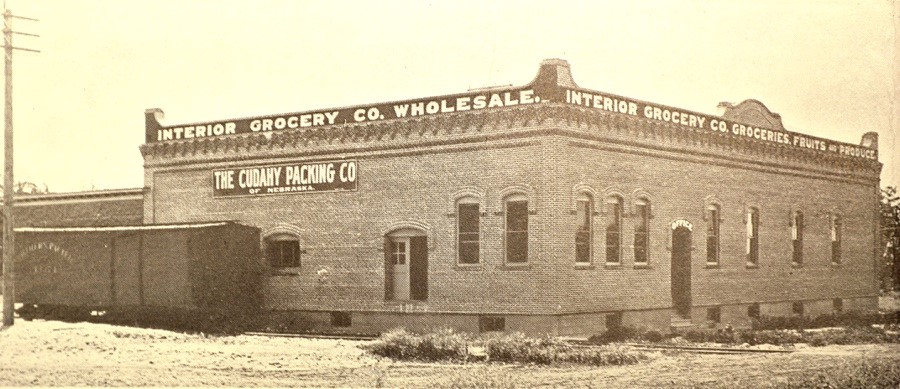
The Interior Grocery Company ca. 1910 showing the north façade on the right and the east façade with a Northern Pacific box car on the rail spur. Photo from Walla Walla: The Garden City, n.d. Courtesy Northwest & Whitman Archives.
By 1908, perhaps because it had outgrown that facility, a determination was made to construct a larger plant, to be located on the southwest corner of what was then the terminus of North 2nd Street at Elm Street. On 2/10/1909, Permit 318 was issued to the Interior Grocery Company to erect a “brick store house” at 1 W. Elm, to cost $11,000. The permit fee was $3. J. A. McLean of 1049 Alvarado Terrace submitted the winning bid of $10,433 for construction. The architect is unknown. McLean was a prominent contractor in this city, as evidenced by the grand house in which he lived on the northwest corner of Alvarado Terrace and North Clinton Street. He served as president of the Walla Walla Commercial Club in 1913. He was low bidder, at $101,506, for an addition – likely the gymnasium – to Walla Walla High School, and at $46,740 for the former Jefferson School on West 9th (destroyed 1983).
In February 1909, Interior Grocery Company applied to the City of Walla Walla to move a fire hydrant in order to allow them to lay a spur from the Northern Pacific Railway along the east side of the building. In March, the Water Committee considered the petition and voted to grant it, providing the Interior Grocery Company pay the fee of $12 for removal of the hydrant. By July the spur had been laid across Elm Street extending the length of the east façade of the building.
An amusing note appeared in The Evening Statesman on December 22nd reporting that on December 20th the Interior Grocery had been entered sometime during the night, and a case of lard and a crate of bacon had been stolen. No clue had been left by the perpetrator.
The first city directory listing for the Interior Grocery Company at “Elm sw corner 2nd” was in the 1909-1910 edition. On 3/16/1910, the firm noted to the City the need of a sidewalk on the north [sic] side of 2nd Street between Oak and Elm Streets. The city agreed that an assessment of how to pay for the desired improvement would be taken up in the near future.
By June 1909, Up-To-The-Times was able to report:
The Interior Grocery Company, of Walla Walla, a wholesale establishment, has just taken up its abode in a fine, new building, which it has erected at the corner of Elm and Second Streets. The new building is a one-story brick, 70 by 100, with an extra high basement. All told it provides for some 20,000 feet of floor space. The building which is located on a side track of the N.P. railway, occupies a very central location. The Interior Grocery Co. owns its new home, which was erected at a cost of some $15,000. A feature of the building is its up-to-date interior appointments which include an electric elevator and other modern conveniences. Interior Grocery is located close to other freight depots. In addition to wholesale fruit and produce, the firm also handles canned goods.
It appears that there is a fairly widely held belief that the subject of this research project was originally the home of the Model Bakery Company, a Walla Walla institution for a number of years. Indeed, this researcher was of that belief and began the project as such. However, niggling developments in the research continued to emerge. The Interior Grocery was at 1 W. Elm, while the Model Bakery, designed by Osterman & Siebert and not built until 1914, was at 2 W. Pine. Eventually, excellent photos of the Model Bakery were found that showed clearly that it was on the northwest corner of North 2nd and Pine, facing Pine; visible in these photos clearly to the north of the Model Bakery is the Interior Grocery Company building. This new building for Model Bakery that first was listed at the 2nd and Pine address in the 1915 city directory served primarily as their production base; they continued to maintain their retail outlet and lunch counter at 3 South 1st for many years.
A permit was issued to Henry DeMotts and Harold Calhoun [sic] on 6/19/1972 to demolish a structure at 2 West Pine, the former Model Bakery Company building. On 6/14/73, it was noted, “Demolished – leveling ground.” A decade later, on 11/23/1982, a second permit was issued to Manuel Maldonado to demolish a building at 2 West Pine. On 3/10/1983 it was recorded, “Bldg. gone only slab & concrete wall left.” Possibly the initial demolition permit was to raze the bakery building, and the second one to level a parking garage for delivery trucks, constructed sometime after 1914 to the west of the original building. Interestingly, it was noted on the second demolition permit, “Called Mr. DeMotts – owner 5-4249 & he gave his OK.” That part of Block 2 formerly occupied by the Model Bakery Company currently provides parking spaces for Corliss Estates Winery that occupies the former Interior Grocery building.
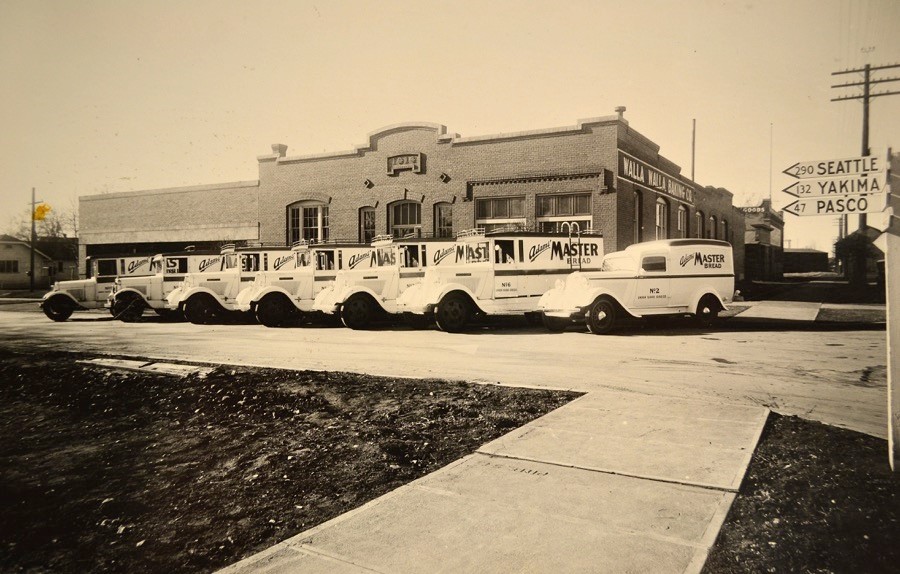
The Model Baking Company building after being renamed Walla Walla Baking Company. The garage on the left is a later addition. The cottage on the far left is one of four that still exist on West Pine Street and North 3rd Avenue. Note the mileage signs that point west on Pine Street. A portion of Interior Grocery may be seen to the rear of the bakery building. Photo courtesy Northwest & Whitman Archives.
In the early photograph of the Interior Grocery Company building it is interesting to note what may have been a later addition to their painted sign that surrounds the cornice on the 2nd and Elm sides. It appears below on the 2nd Street side and reads, The Cudahy Packing Company of Nebraska. Although Interior Grocery billed itself as a wholesale business dealing in fruit and produce, Cudahy was a meat packing firm, originally part of Armour in Milwaukee, so Interior Grocery evidently dealt to some degree in the distribution of meat products.
The Spokane Spokesman-Review reported on 4/23/1929 in an article entitled, “Interior Grocery Is Sold,” that Wadhams & Company, wholesale grocer of Portland, Oregon, had purchased an interest in the Interior Grocery Company of Walla Walla. It was noted that Interior Grocery does nearly a one-million-dollar business annually. Manager Fred Glaske was to stay on as manager, but the firm would be operated henceforth as a unit of the Red and White grocery chain. (Fred Glaske was active in a number of organizations and causes in Walla Walla. His biography is included in Prof. W. D. Lyman’s History of Old Walla Walla County, Vol. 1, Page 593. He died November 25, 1931, aged 75.)
The Walla Walla Union-Bulletin reported on 12/20/1945 that a new freezing room had been constructed in the building due to the fact that frozen foods were becoming increasingly popular following World War II.
Despite the Spokesman-Review’s stating that as of 1929 the Interior Grocery Company would be operated as part of the Red and White grocery chain, it maintained its original name in Walla Walla. Nonetheless, its last listing in a city directory occurred in 1956. On 3/2/1957, the Union-Bulletin reported that the warehouse at 2nd and Elm would be cleared out, and six days later wrote that it would be liquidating its business here, and would from that point on be a beer distributor, known as Glafke Distributing Company, managed by Ralph Glafke of Portland.
The former Interior Grocery Company building is a post-and-beam structure, one and one-half stories, with full basement, and brick façade. Some architectural interest can be seen in the faux corbels, suggested by projecting some of the bricks under the cornice outward from the façade. Directly below these is a double string course, also formed by projecting the bricks outward.
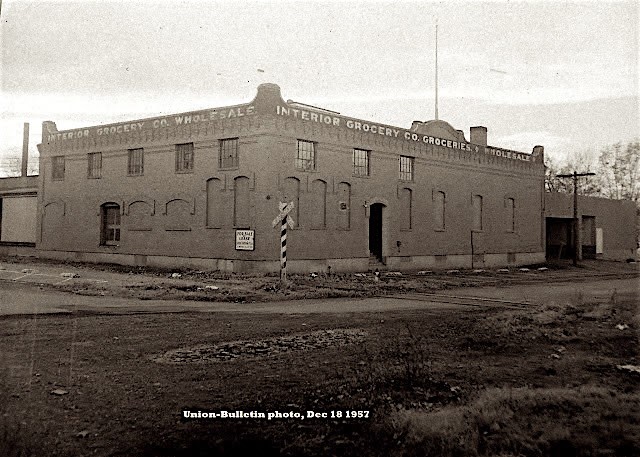
The Interior Grocery building with a For Sale sign, December 18, 1957. Note the rail spur is still intact and from the appearance of this photo it would seem that North 2nd and the former West Elm Street, now vacated, was at the northern terminus of the city. Union-Bulletin photo, courtesy of Northwest & Whitman Archives and Joe Drazan.
Segmented arch windows, irregular in shape and placement, and the raised corners of the cornice break the monotony of the façade. In the end, this is an industrial building; its appearance and construction technique are representative of industrial buildings built throughout the country during the first two decades of the 20th century. Ornamentation was, at best, a secondary consideration. Sweeping changes made by the current owner to both the north and south façades have resulted in a far more architecturally sophisticated appearing building, relieving it of its earlier “plain Jane” appearance. Along with the current landscaping, the former Interior Grocery Company building is a welcoming beacon for visitors at this main downtown freeway exit to Walla Walla.
(A smaller poured concrete addition to the west side was built sometime after 1909, and in recent years a second, larger concrete addition has been added to the west side (Lot 5), expanding the western extremity of the building to North 3rd Avenue.)
References
- Whitman Archives
- Sanborn Fire Map, 1905 and 1923 update to 1905 map
- Washington Statesman, 4/19/1862
- Washington Reports of Cases Determined In the Supreme Court of the State of Washington, 1890 and March 28 – June 8, 1912
- The Timberman, June 1913
- Up-To-The-Times, various dates 1909-1910
- Joe Drazan’s Bygone Walla Walla blog
- Building and Engineering News, April 5, 1916
- City of Walla Walla Planning and Zoning Development Services
- Lyman, W. D., History of Old Walla Walla County, Vol. 1, 1918
- Bennett, Robert A., Walla Walla: A Town Built To Be A City, 1900-1919, 1982
- Walla Walla: The Garden City, undated promotional booklet, republished by Ellen Saager, 2012
- Spokesman-Review, Spokane, 4/23/1929
- Walla Walla: The Garden City, n.d.
- Walla Walla Evening Statesman, various dates 1909
- Walla Walla Union-Bulletin, various dates 1946, 1947, 1949, 1965
- Special thanks to Walla Walla historian Susan Monahan

